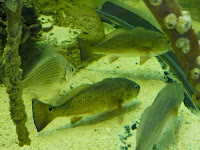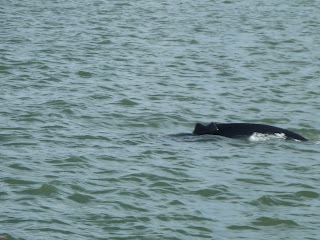 The yellow stingray (Urobatis jamaicensis), is also sometimes called the yellow spotted stingray. Their range stretches out from North Carolina, to Northern South America. They have an interesting feeding technique. They will lift their front half up so they resemble a cave, then their prey goes right to them thinking that the stingray is a cave.
The yellow stingray (Urobatis jamaicensis), is also sometimes called the yellow spotted stingray. Their range stretches out from North Carolina, to Northern South America. They have an interesting feeding technique. They will lift their front half up so they resemble a cave, then their prey goes right to them thinking that the stingray is a cave.Wednesday, November 20, 2013
Yellow Stingray
 The yellow stingray (Urobatis jamaicensis), is also sometimes called the yellow spotted stingray. Their range stretches out from North Carolina, to Northern South America. They have an interesting feeding technique. They will lift their front half up so they resemble a cave, then their prey goes right to them thinking that the stingray is a cave.
The yellow stingray (Urobatis jamaicensis), is also sometimes called the yellow spotted stingray. Their range stretches out from North Carolina, to Northern South America. They have an interesting feeding technique. They will lift their front half up so they resemble a cave, then their prey goes right to them thinking that the stingray is a cave.Tuesday, November 5, 2013
Mote Intern Camping Trip
 |
| Bottlenose Dolphin |
 |
| Bottlenose Dolphin with Calf |
 |
| Bottlenose Dolphin |
 |
| Gopher Tortoise |
 Last weekend, I and eight other interns from the Mote went camping. We went on a dolphin boat and we got to help identify dolphins. We also went to Rookery Bay and to the Corkscrew Swamp Sanctuary. We saw lots of animals, including a huge alligator and a friendly praying mantis.
Last weekend, I and eight other interns from the Mote went camping. We went on a dolphin boat and we got to help identify dolphins. We also went to Rookery Bay and to the Corkscrew Swamp Sanctuary. We saw lots of animals, including a huge alligator and a friendly praying mantis.  |
| Bottlenose Dolphins |
 |
| Bottlenose Dolphin |
 |
| Corkscrew Swamp Sanctuary |
 |
| Frigate Birds |
 |
| Corkscrew Swamp Sanctuary |

Tuesday, October 29, 2013
Snorkling Pictures
.JPG) |
| Common Snook (Centropomus undecimalis) |
.JPG) |
| Sergeant Major (Abudefduf saxatilis) |
.JPG) |
| Stone Crab (Menippe mercenaria) |
(you can click on the photos to enlarge.)
.JPG) |
| Sergeant Major (Abudefduf saxatilis) |
.JPG) |
| Common Snook (Centropomus undecimalis) |
 |
| Sheepshead (Archosargus probatocephalus) |
 |
| Scaled Sardine (Harengula jaguana) |
 |
| Lesser Butterfly Ray (Gymnura micrura) |
 |
| Pinfish (Lagodon rhomboides) |
Tuesday, October 22, 2013
Spongy Decorator Crab
 The spongy decorator crab (Marcocoeloma trispinosum), is a species of decorator crab. They will put sponges, corals, and other things on themselves to camouflage. The one in the picture has covered himself with mushroom polyps. They stick the camouflage of choice on themselves like Velcro. They have little hook life hairs on their body which helps attach things to them. They will even change what they have on them depending on what is in their environment.
The spongy decorator crab (Marcocoeloma trispinosum), is a species of decorator crab. They will put sponges, corals, and other things on themselves to camouflage. The one in the picture has covered himself with mushroom polyps. They stick the camouflage of choice on themselves like Velcro. They have little hook life hairs on their body which helps attach things to them. They will even change what they have on them depending on what is in their environment.Tuesday, October 15, 2013
Strate Bubbles
 Strate bubbles (Bulla striata) are also called common Atlantic bubbles. Bubbles are gastropods. Bubbles are related to sea hares and nudibranchs. When there foot and mantle are extended, they can completely cover their shell. Unlike most gastropods, they don't have eye stalks; instead their eyes are directly on their head.
Strate bubbles (Bulla striata) are also called common Atlantic bubbles. Bubbles are gastropods. Bubbles are related to sea hares and nudibranchs. When there foot and mantle are extended, they can completely cover their shell. Unlike most gastropods, they don't have eye stalks; instead their eyes are directly on their head.
Tuesday, October 8, 2013
Airport Art Contest
 Recently, I have been working on a picture for the Sarasota Bradenton International Airport art contest. I have my picture finished, but I could use some ideas on the background. If you have any ideas, please leave a comment on this post. Thanks!
Recently, I have been working on a picture for the Sarasota Bradenton International Airport art contest. I have my picture finished, but I could use some ideas on the background. If you have any ideas, please leave a comment on this post. Thanks! Update- I have sent in my picture with a background. I decided on Blue with green streaks going left to right.
Tuesday, October 1, 2013
Stingrays, Stingrays, and More Stingrays!
 |
| Stingray Under The Sand |
 |
| Two Atlantic Stingrays |
Tuesday, September 17, 2013
Cownose Ray
The cownose ray (Rhinoptera bonasus) is a species of ray. It gets it's name from the shape of it's head because it looks like a cow's nose. To find their prey, they will either flap there fins to stir up the sand, or they will move the sand around with their snouts. Once they have located there prey, they will rapidly flap their fins to reveal their prey. Cownose rays will migrate by the thousands from the Gulf of Mexico, and up the east side of the U.S.. Their natural predators include cobia and sharks. They are not commercially fished by people. However, the Virginia Sea Grant at VIMS is trying to persuade people to start eating cownose rays because a main part of their diet is oysters. But since cownose rays usually only have one pup at a time, it could cause a decrease in the population like the thylacines did. Cownose rays are commonly kept in touch tanks in aquariums. I don't think that I have ever been to a stingray touch tank where they did not have cownose rays.
Tuesday, September 10, 2013
Mandarin Dragonet
 The mandarin dragonet (Synchiropus splendidus), is a tropical from the family Callionymidae. Mandarin dragonets go by many different names including mandarin goby and mandarin fish. They usually live in small groups in the wild. Mandarin dragonets produce a thick mucus that covers them and is toxic to whatever might try to eat it. Mandarin dragonets will dull in color when they are going to rest at night. Mandarin dragonets are popular in marine pet stores, despite the fact that they are difficult to feed because they eat amphipods and other small invertebrates.
The mandarin dragonet (Synchiropus splendidus), is a tropical from the family Callionymidae. Mandarin dragonets go by many different names including mandarin goby and mandarin fish. They usually live in small groups in the wild. Mandarin dragonets produce a thick mucus that covers them and is toxic to whatever might try to eat it. Mandarin dragonets will dull in color when they are going to rest at night. Mandarin dragonets are popular in marine pet stores, despite the fact that they are difficult to feed because they eat amphipods and other small invertebrates.Thursday, July 18, 2013
Beach finds
There finds were found a few weeks ago, but I have had a very busy schedule and have not had much time to post on my blog. The two top photos are the stuff which I kept, and the last photo is the stuff that I either recycled or threw away. The best find that I found that day was the shark tooth necklace in the first picture. It was far from where most people stay when they go to Lido.
Tuesday, June 4, 2013
Lightning Whelks
 |

Tuesday, May 21, 2013
Olive Snails
 |
| Olive Snail Shells |
 |
| Live Olive Snail |
Tuesday, April 30, 2013
Colorful Moonsnail
 The colorful moonsnail (Naticarius canrena), are gastropods. They are uncommon at the beaches that I have been to (that is why I only have one).
The colorful moonsnail (Naticarius canrena), are gastropods. They are uncommon at the beaches that I have been to (that is why I only have one).Moonsnails prey on buried bivalves. Their foot is about ten times the size of their shell and is light colored with brown streaks running down it.
Thursday, April 4, 2013
Rubber Snakes to Silver Spoons (Another Trip to Lido)
 |
| Common Sand Toys |
 |
| Strings and Other Long Stretchy Things |
 |
| Stranger Things to Find on Lido Beach |
Speaking of rubber snakes, there once was a dolphin who ate a rubber snake that someone discarded. It is really important that trash and other things like toys, do not get left on the beach. (If any of these are yours, and you are near Lido beach, I can give it back to you.)
Tuesday, March 12, 2013
Ray or Stingray or Skate
 |
| Clearnosed skate at the Mote Marine Laboratory |
 |
| Atlantic stingray at the Florida Aquarium |
Stingrays and different then rays for many reasons. Stingrays usually are on the sea floor, their barb is farther away from their body, they usually have rounder fins, and stingrays will cover themselves with sand to hide from predators.
 |
| Cownose ray at the Mote Marine Laboratory |
Subscribe to:
Comments (Atom)



.JPG)


.JPG)





